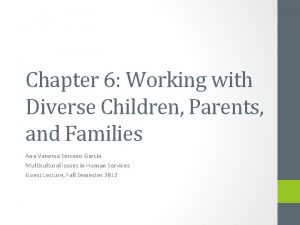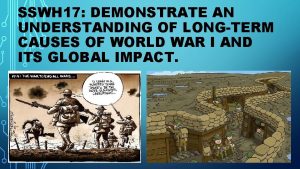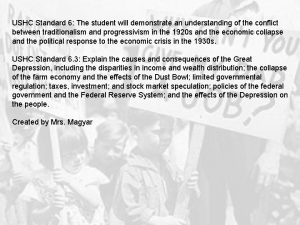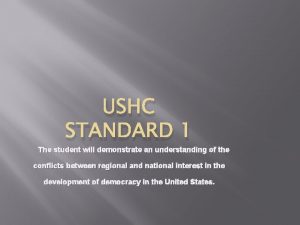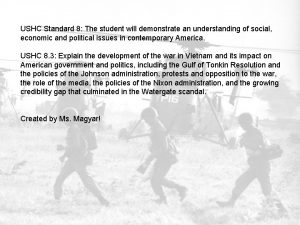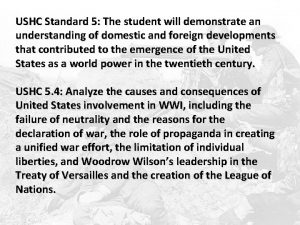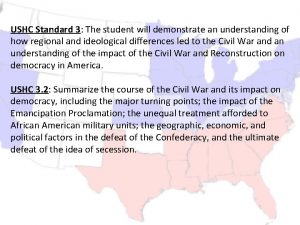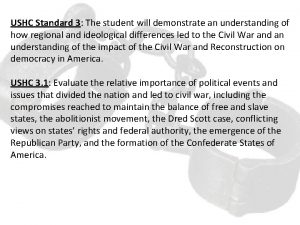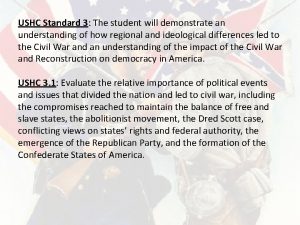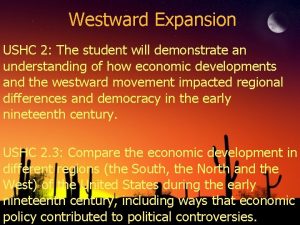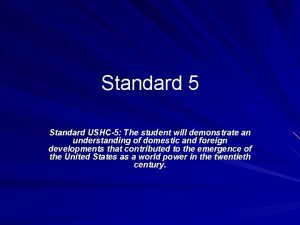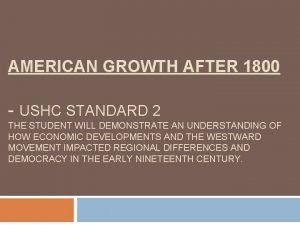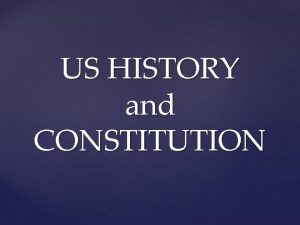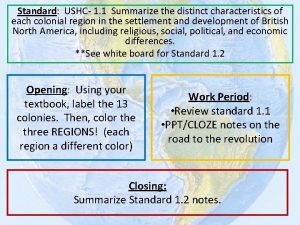USHC Standard 3 The student will demonstrate an




















- Slides: 20

USHC Standard 3: The student will demonstrate an understanding of how regional and ideological differences led to the Civil War and an understanding of the impact of the Civil War and Reconstruction on democracy in America. USHC 3. 1: Evaluate the relative importance of political events and issues that divided the nation and led to the civil war, including the compromises reached to maintain the balance of free and slave states, the abolitionist movement, the Dred Scott case, conflicting views on states’ rights and federal authority, the emergence of the Republican Party, and the formation of the Confederate States of America.

How did westward expansion affect democracy in the United States? GOOD? 1. Democracy expanded in the United States as new territories were claimed, settled and entered the union as full partners under the terms of the Northwest Ordinance. BAD? 2. Expansion led to the greatest challenge to democracy and the Southern elite became increasingly determined to maintain slavery.

How did sectionalism increase during westward expansion? As new western states applied for admission to the Union, sectionalism increased as the divisions between the interests of the regions became more and more evident

MAINTAINING THE BALANCE OF REGIONAL POWER The struggle to maintain the balance of power between slave and free states in the federal government was rooted in the compromises made at the Constitutional Convention over representation in Congress—equal representation of the states in the Senate and representation proportional to population in the House.


WHY? • Because of the growing populations of the northern and western states through immigration and westward movement, the South was losing the ability to protect southern interests in the House of Representatives • This led Southerners to fight to maintain an equal number of slave and free states so they would have an equal number of votes in the Senate.

What problems did slavery cause between the regions? Tensions between the regions over the expansion of slavery increased between 1820 and 1860 until compromise was impossible MAP

Problems with westward expansion: • The annexation of Texas was delayed for almost a decade because of the tensions that would occur from admitting another large slave state


Political problems: • Northerners saw the Polk administration’s willingness to give up portions of Oregon, while at the same time provoking a war with Mexico over territories in the southwest as the influence of the slave power

• During the Mexican War, Representative David Wilmot of Pennsylvania proposed the Wilmot Proviso

• Wilmot Proviso: the U. S. should assert that any territories won from Mexico be “free soil”, not open to competition of slave labor with that of free white labor • The Wilmot Proviso passed the House of Representatives but was stopped in the Senate, giving further evidence to southerners that they must maintain the balance of slave and free states in order to protect their “peculiar institution”

• The gold rush in 1849 increased the population of California and its application for statehood as a free again upset the balance

Compromises: • The Missouri Compromise overcame the Northern opposition to Missouri entering the Union as a slave state • Missouri Compromise: an act of Congress (1820) by which Missouri was admitted as a slave state, Maine as a free state, and slavery was prohibited in the Louisiana Purchase north of latitude 36° 30′N, except for Missouri.


• The Compromise of 1850 introduced the principle of popular sovereignty to decide the slave question. • Compromise of 1850: California was admitted as a free state, the slavery question in other areas taken in the Mexican cession was to be decided based on popular sovereignty, the sale of slaves was prohibited in Washington, D. C. , and a new fugitive slave law was to be enforced by the federal government.


• Fugitive Slave Laws: laws passed by the United States Congress in 1793 and 1850 to provide for the return of slaves who escaped from one state into another state or territory • Popular Sovereignty: the doctrine that sovereign power is vested in the people and that those chosen to govern, as trustees of such power, must exercise it in conformity with the general will

Did the Compromises work? No! • No one was happy with all parts of the Compromise of 1850. • Efforts by southerners to reclaim their fugitive slaves were countered by Northern states trying to avoid the law and protect personal liberty

MAIN IDEA: The compromises intensified the animosity between the regions
 After death hair
After death hair What does this image demonstrate
What does this image demonstrate Demonstrate
Demonstrate Isodiametric hair
Isodiametric hair Demonstrate two
Demonstrate two Mt carmel contest
Mt carmel contest Demonstrative pronouns examples
Demonstrative pronouns examples Demonstrate knowledge and understanding
Demonstrate knowledge and understanding Demonstrate
Demonstrate Demonstrate good subject and curriculum knowledge
Demonstrate good subject and curriculum knowledge Cindy rich
Cindy rich Edip method
Edip method Demonstrate your ability
Demonstrate your ability Miller and urey's experiments attempted to demonstrate
Miller and urey's experiments attempted to demonstrate Demonstrate
Demonstrate Purpose of demonstration
Purpose of demonstration Bicultural couples tend to demonstrate extremes in
Bicultural couples tend to demonstrate extremes in Demonstrate
Demonstrate Edwin states pride has no
Edwin states pride has no Chapter 13 personal care skills
Chapter 13 personal care skills Demonstrate
Demonstrate
















